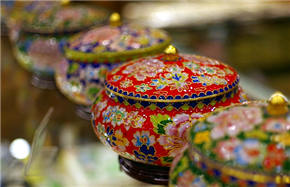Real estate to canvas
Featured artists include Cai Guoqiang, a New York-based artist whose fireworks performance project Sky Ladder held in 2015 in China was sponsored by Xu. The two hail from Quanzhou, East China's Fujian province.
Zhan Wang's stainless steel sculptures from his best-known Artificial Rocks series are also on show.
He has modeled the works after jiashanshi (artificial rocks), a common decoration in classical Chinese gardens, and seeks a communication between cultural traditions and contemporary technologies.There are also works of up-and-coming artists like Dong Lin who is a postgraduate student at Beijing's Central Academy of Fine Arts. She spends a lot of time working in Jingdezhen, Jiangxi province, which is known as the porcelain capital of China. Her three porcelain installations on display are inspired by Shanhaijing, a classic compilation of texts on myths.
What is at the heart of Xu's collection and the museum's showcase is a dozen of paintings created by ink-brush masters of 20th-century China. They cost a great sum of money when Xu made successful bids on them at auction. They are now on display together to the public for the first time since Xu bought them.
Highlights include Zhichi Tianya, an album of 12 landscapes by Qi Baishi, which fetched 195.5 million yuan ($29.6 million) last year, Zhang Daqian's painting, titled A Copy of Ju Ran's Landscape, which sold for 103.5 million yuan, and Huang Zhou's Joyful Grassland, on which Xu spent 128.8 million yuan in 2013.
Li Xiaofeng, director of the Powerlong Museum, says one of their missions has been to show how Chinese ink-brush art evolved throughout the 20th century. Future exhibitions will focus on the masters and the different painting schools they heralded.
"The Chinese cultural identity is important as China integrates with the world. That will be the topic we will continue to center our exhibitions around, and invite audiences to anticipate the development of Chinese culture over the next 100 years," Li says.


















